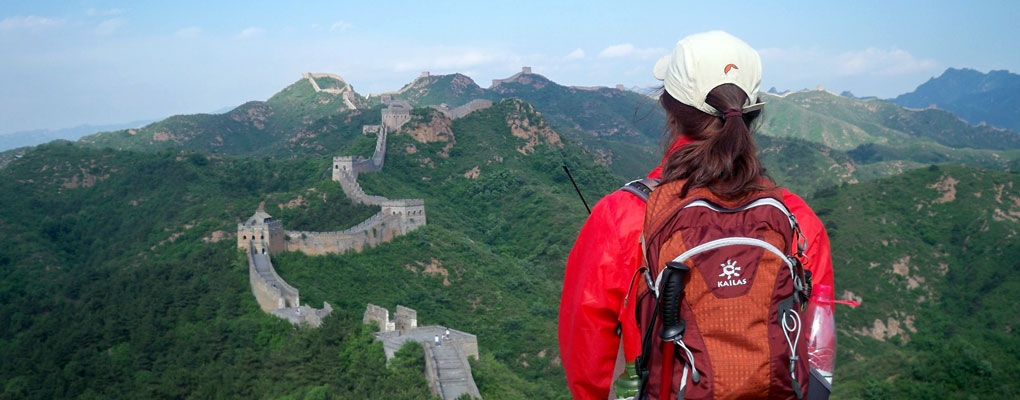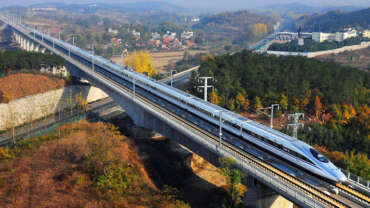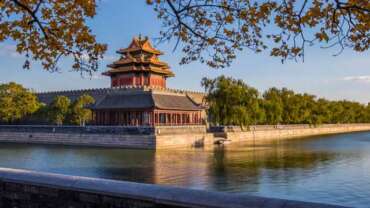China - The Great Wall
A symbol of ancient Chinese civilization, the Great Wall of China is one of the world’s oldest and most magnificent man-made scenes, which can even be seen from the space. It enjoys the same reputation with another two landmarks of China – Forbidden City and Terracotta Army. Given its outstanding architectural achievement and remarkable historical influence, the Great Wall was listed as a UNESCO World Natural and Cultural Heritage site in 1987, the first of its kind in China.
The Great Wall was originally built over 2500 years ago during the West Zhou Dynasty, and served as a functional military defense to prevent the invasion of the northern nomadic minorities. It had been playing a crucial role in wars in ancient Chinese history, therefore, the walls were continually to be extended in the next 2000+ years, till the end of Ming Dynasty. As a result, the Great Wall was expanded to 15 provinces and municipalities in China, and formed in a beautiful shape of “Long” (Chinese style dragon). There are Northern Great Wall and Southern Great Wall, according to location. With its original thousands of miles length (Northern Great Wall), it was widely named “Wan Li Chang Cheng” (Long Wall of Ten Thousand Li). But actually the Great Wall of Ming Dynasty is 8851.8 km or 20,000 li long, much longer than the original 10,000 li.
Through thousands of years and the replacement of the dynasties, many parts of the Great Wall have been severely damaged from erosion, and some are even endangered and have disappeared. The present preserved Great Wall was mainly built in 14 century, hence called Ming Great Wall, which starts in the Hushan in Liaoning Province and end in Jiayuguan of the eastern point. Today, Beijing, Chengde in Hebei Province, Yulin in Shannxi Province and Jiayuguan in Gansu Province are the top destinations for Great Wall sightseeing or hiking. And the most famous sections of China Great Wall include Badaling, Mutianyu, Jinshanling, Simatai, Jiayuguan Pass, Juyongguan Pass and Shanhaiguan Pass. Among them, Mutianyu section is most recommended to international travelers. While Jinshanling and Simatai sections are best for hiking or trekking.
The Great Wall is a place steeped in history and offers a lot to discover. For those who are fascinated with it and greedy for knowledge about it, on this page, you will find massive information of Great Wall, the historical development, the background stories, the building glamour and its facts and figures. The introduction of some wild Great Wall in Beijing is provided as well.
Obviously, a Great Wall tour is a must when you’re in China. So we have crafted dozens of Great Wall tour packages, and here list the best-selling ones for you. Please feel free to send us an inquiry. Besides, to ensure you a best Great Wall experience, we provide you very useful travel tips about the hiking routes, transportation, accommodation, restaurant, as well as the Great Wall maps.
No matter you are a history-loving traveler or a freak of natural landscape, you will never get tired of the Great Wall — one of the seven wonders in the world.
Silk Road Facts
The Silk Road is a route to discover the history and the ancient culture about China. In its Chinese section, it stretches more than 4,000km linking cities like Xi’an, Lanzhou, Xining, Dunhuang, Turpan and Urumqi from east to west China. In Silk Road’ heyday, Korean peninsula, Japan region, Indian peninsula, Mediterranean east bank area and Middle East region, all involved in this international trading route. Xi’an was the world richest city in the world and crowded by the merchant all across the globe in the Silk Road heyday. Today Xi’an is modern city of central China with similar population with London and yet still it is not the top ten best cities in China. In the west, it was during the time of the Byzantine Empire, the Silk Road reached its peak.
The Silk Road also represents an early phenomenon of political and cultural integration due to inter-regional trade. Immeresly goods and treasures were not the only thing that got exchanged through the ancient route, religions and cultural traditions were also spread along the Silk Roads. Buddhism and Islam both spread into China though the Silk Road, numerous western merchants settled down in ancient China and merged in those ethnic group people along the silk route.
The Silk Road was not just a road or a trading route, the concept also refers to both the terrestrial and the maritime routes connecting Asia and Europe. The overland Steppe route stretching through the Eurasian steppe is considered to be the ancestor to the Silk Road. It was during the Ming dynasty in ancient China, the maritime silk route had reached its peak. It was after the Ming dynasty —— during the Yuan dynasty that the world-known Venetian traveler Marco Polo followed silk route reached China overland via Khotan in 1287–88.
Badaling Great Wall
Badaling Great Wall, also known as Ba Da Ling (八达岭) in Chinese spelling is the most representative part of the Great Wall of China, as well as the most visited section. It is located in Yanqing County, over 70 kilometers (43 miles) the northwestern suburbs of Beijing city. The Great Wall is a symbol of ancient Chinese civilization and a world-renowned fortification. Stretching 6,350 kilometers on the mountains in Northern China, the Great Wall was first built in the 7th century B.C. and completed during the reign of the first Emperor of Qin. It was extended during the Ming Dynasty. Being one of the “seven wonders of the world”, it has been listed as a world cultural heritage.
Mutianyu Great Wall
Mutianyu Great Wall is located in Huairou District, Beijing, 73 kilometers away from Beijing downtown area. It is one of the famous sections of China Great Wall. Mutianyu Great Wall was first built in the mid-6th century during the Northern Qi, making it older than the Badaling section. In 1569, the Mutianyu Great Wall was rebuilt and till today most parts of it are well preserved. The Mutianyu Great Wall has the largest construction scale and best quality among all sections of Great Wall.
Jinshanling Great Wall
Jinshanling Great Wall is one of the best preserved parts of the Great Wall which may shows its charms to the hiking fans at all times. With a distance about 140 kilometers (87 miles) northeast of Beijing city, Jinshanling Section connects to the Simatai Section of the wall in the east and Gubeikou section in the west. It is the most representative part of the Chinese brick-made dragon.
Gubeikou Great Wall
Gubeikou section is the most complete part of the Great Wall since it had been built up. Located along the Yanshan Mountain range in the northeast of Miyun County, Gubeikou Great Wall welcomes people who are fond of adventures.
Simatai Great Wall
For adventurers and hiking fans, Simatai section of the Great Wall is more attractive than the other two sections Badaling and Mutianyu. Simatai Great Wall is situated in the Gubeikou Town in the northeast of Miyun County, Beijing. This well-preserved and undeveloped site possesses the most charming scene of the Great Wall. With the breath-taking landscape surrounding the glorious Great Wall, Simatai is the best choice for adventurers and photographers.
Jiankou Great Wall
Jiankou Great Wall is located about 30 km away from Huairou County, outskirt of Beijing. The mountains around are quite different from each other. Jiankou Great Wall above steep mountains and cliffs seems more magnificent, as well as more advantageous.Mutianyu Great Wall is on the east side of it, and Dazhenyu Great Wall on the west. Jiankou Great Wall got its name because it is W-shaped, looking like a full bow buckling an arrow. Jiankou Great Wall is one of the most dangerous sections of the Great Walls of China. It lists the most times on all kinds of painting albums of the Great Wall. It has always been a hot spot for the photographs of the Great Walls of China.
Shanhaiguan Pass
Shanhaiguan Pass or Shanhai Pass is called as the “First Pass under Heaven”. This great architecture is located in Qinhuangdao as a part of this city. In 1961, Shanhaiguan became a site of China First Class National Cultural Site. With the other two famous Great Wall passes Jiayuguan and Juyongguan, they are three major pauses of the Great Wall of China.
Jiayuguan Pass
Jiayuguan Pass, or Jiayuguan Fortress, is the first pass at the west of the Great Wall of China. It is situated between the Wenshu and Heishan Mountains at the foot of Jiayuguan Hill of Qilian Mountain. Along with Juyongguan and Shanhaiguan, it is one of the main passes of the Great Wall.
With a length of 733 meters and an area about 33,500 square meters, Jiyuguan Pass has tow gates that one on the east side of the pass, and the other on the west side. On each gate there is a building. It consists of three defense lines: an inner city, an outer city and a moat.
Jiayuguan Pass is well-known as “the Impregnable Pass under the Heaven”. It is also the most magnificent and best-preserved pass among the total over one thousand passes along the Great Wall of China. Jiayuguan Pass was built in the early Ming dynasty, about 1372. It was built on the extreme western edge of China. Legend has it that the official in charge asks the designer to calculate how many bricks would be used. The designer gives him the number and when the project is finished, only one brick is left. It is put on the top of the pass as a symbol of commemoration.







